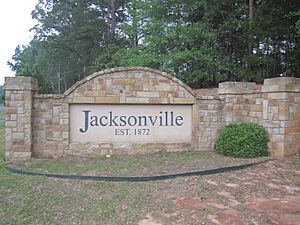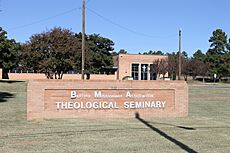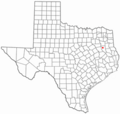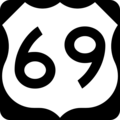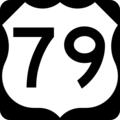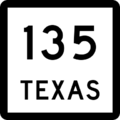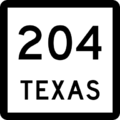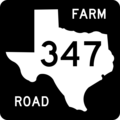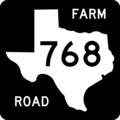Jacksonville, Texas facts for kids
Quick facts for kids
Jacksonville, Texas
|
|
|---|---|
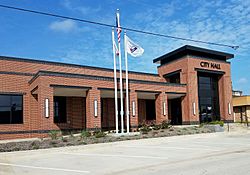
Jacksonville's City Hall, located downtown on South Ragsdale Street, was completed in November 2016.
|
|
| Nickname(s):
The Biggest Small Town in Texas;
Tomato Capital of the World |
|
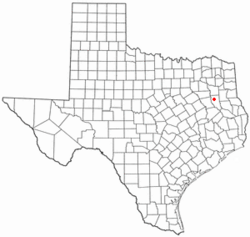
Location of Jacksonville, Texas
|
|
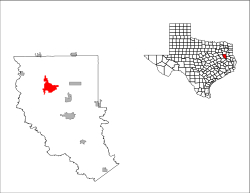 |
|
| Country | |
| State | |
| County | Cherokee |
| Government | |
| • Type | Council-Manager |
| Area | |
| • Total | 14.20 sq mi (36.77 km2) |
| • Land | 14.19 sq mi (36.75 km2) |
| • Water | 0.01 sq mi (0.02 km2) |
| Elevation | 505 ft (154 m) |
| Population
(2020)
|
|
| • Total | 13,997 |
| • Density | 1,043.97/sq mi (403.09/km2) |
| Time zone | UTC-6 (Central (CST)) |
| • Summer (DST) | UTC-5 (CDT) |
| ZIP code |
75766
|
| Area code(s) | 430, 903 |
| FIPS code | 48-37216 |
| GNIS feature ID | 2410130 |
| U.S. Highways | |
| Major State Highways | |
| Website | http://www.jacksonvilletx.org |
Jacksonville is a city in Cherokee County, Texas, United States. About 14,000 people lived there in 2020. It's the main city in the Jacksonville area, which includes all of Cherokee County.
You can find Jacksonville in East Texas. It's north of Rusk, the county seat, and south of Tyler.
Jacksonville is known as the "Tomato Capital of the World." This is because a lot of tomatoes are grown and shipped from here. The city has a famous red iron ore rock stadium called the Tomato Bowl. Workers built it during the Great Depression. It's where the Jacksonville High School "Fightin' Indians" football and soccer teams play. Every year, Jacksonville hosts fun events like the "Tops in Texas Rodeo" in May and the "Tomato Fest" in June.
Contents
History of Jacksonville, Texas
Jacksonville started in 1847 as a town called Gum Creek. A man named Jackson Smith built a home and a blacksmith shop there. He became the postmaster in 1848 when a post office was approved. Soon after, Dr. William Jackson opened his office near Smith's shop.
When the town was officially planned in 1850, it was named Jacksonville. This name honored both Jackson Smith and Dr. William Jackson. The post office name also changed from Gum Creek to Jacksonville in June 1850.
Geography and Climate of Jacksonville
Jacksonville covers about 14.1 square miles (36.7 square kilometers) of land. Only a tiny part is water.
Lake Jacksonville: A City Water Source
Lake Jacksonville is a lake located three miles (5 km) southwest of the city. It is the main source of water for Jacksonville. It's also a popular spot for outdoor activities and homes.
The lake was created in 1957. City leaders thought it would take many years to fill with water from nearby creeks. However, thanks to a very rainy season, the lake filled up completely in just one year!
- Lake facts:
- Location: 3 miles southwest of Jacksonville, off US 79
- Size: 1,320 acres (about 5.3 square kilometers)
- Deepest point: 62 feet (about 19 meters)
- Year created: 1957
Jacksonville's Weather Patterns
Jacksonville's weather records go back to 1953. In February 2021, during a very cold period known as the 2021 Texas power crisis, Jacksonville experienced its coldest temperature ever recorded.
| Climate data for Jacksonville, Texas (1991–2020 normals, extremes 1953–present) | |||||||||||||
|---|---|---|---|---|---|---|---|---|---|---|---|---|---|
| Month | Jan | Feb | Mar | Apr | May | Jun | Jul | Aug | Sep | Oct | Nov | Dec | Year |
| Record high °F (°C) | 85 (29) |
91 (33) |
90 (32) |
95 (35) |
99 (37) |
103 (39) |
110 (43) |
108 (42) |
109 (43) |
100 (38) |
89 (32) |
83 (28) |
109 (43) |
| Mean daily maximum °F (°C) | 58.2 (14.6) |
62.5 (16.9) |
70.1 (21.2) |
77.2 (25.1) |
83.2 (28.4) |
89.9 (32.2) |
93.9 (34.4) |
94.3 (34.6) |
88.9 (31.6) |
79.2 (26.2) |
68.3 (20.2) |
60.7 (15.9) |
77.2 (25.1) |
| Daily mean °F (°C) | 46.0 (7.8) |
49.8 (9.9) |
56.7 (13.7) |
64.1 (17.8) |
72.2 (22.3) |
79.1 (26.2) |
82.8 (28.2) |
82.4 (28.0) |
76.6 (24.8) |
66.4 (19.1) |
55.8 (13.2) |
48.8 (9.3) |
65.1 (18.4) |
| Mean daily minimum °F (°C) | 33.8 (1.0) |
37.1 (2.8) |
43.3 (6.3) |
51.0 (10.6) |
61.2 (16.2) |
68.3 (20.2) |
71.6 (22.0) |
70.5 (21.4) |
64.2 (17.9) |
53.5 (11.9) |
43.2 (6.2) |
36.9 (2.7) |
52.9 (11.6) |
| Record low °F (°C) | 5 (−15) |
−6 (−21) |
15 (−9) |
28 (−2) |
39 (4) |
50 (10) |
57 (14) |
54 (12) |
43 (6) |
29 (−2) |
14 (−10) |
5 (−15) |
−6 (−21) |
| Average precipitation inches (mm) | 4.54 (115) |
4.24 (108) |
3.80 (97) |
3.38 (86) |
4.26 (108) |
4.04 (103) |
3.40 (86) |
3.07 (78) |
3.55 (90) |
4.75 (121) |
4.24 (108) |
4.23 (107) |
47.50 (1,207) |
| Average snowfall inches (cm) | 0.2 (0.51) |
0.0 (0.0) |
0.0 (0.0) |
0.0 (0.0) |
0.0 (0.0) |
0.0 (0.0) |
0.0 (0.0) |
0.0 (0.0) |
0.0 (0.0) |
0.0 (0.0) |
0.0 (0.0) |
0.0 (0.0) |
0.2 (0.51) |
| Average precipitation days (≥ 0.01 in) | 7.8 | 8.2 | 7.8 | 6.1 | 6.5 | 6.5 | 5.5 | 4.9 | 5.3 | 6.0 | 6.8 | 8.6 | 80.0 |
| Average snowy days (≥ 0.1 in) | 0.2 | 0.1 | 0.0 | 0.0 | 0.0 | 0.0 | 0.0 | 0.0 | 0.0 | 0.0 | 0.0 | 0.0 | 0.3 |
| Source: NOAA | |||||||||||||
People of Jacksonville: Demographics
| Historical population | |||
|---|---|---|---|
| Census | Pop. | %± | |
| 1880 | 349 | — | |
| 1890 | 970 | 177.9% | |
| 1900 | 1,558 | 60.6% | |
| 1910 | 2,875 | 84.5% | |
| 1920 | 3,723 | 29.5% | |
| 1930 | 6,748 | 81.3% | |
| 1940 | 7,213 | 6.9% | |
| 1950 | 8,607 | 19.3% | |
| 1960 | 9,590 | 11.4% | |
| 1970 | 9,734 | 1.5% | |
| 1980 | 12,264 | 26.0% | |
| 1990 | 12,765 | 4.1% | |
| 2000 | 13,868 | 8.6% | |
| 2010 | 14,544 | 4.9% | |
| 2020 | 13,997 | −3.8% | |
| U.S. Decennial Census | |||
In 2020, Jacksonville had 13,997 residents. There were 5,027 households and 3,670 families living in the city.
| Race | Number | Percentage |
|---|---|---|
| White (NH) | 4,915 | 35.11% |
| Black or African American (NH) | 2,747 | 19.63% |
| Native American or Alaska Native (NH) | 25 | 0.18% |
| Asian (NH) | 105 | 0.75% |
| Pacific Islander (NH) | 5 | 0.04% |
| Some Other Race (NH) | 47 | 0.34% |
| Mixed/Multi-Racial (NH) | 404 | 2.89% |
| Hispanic or Latino | 5,749 | 41.07% |
| Total | 13,997 |
Fun and Recreation in Jacksonville
The Jacksonville Public Library has served the city and Cherokee County for over 70 years. It's part of several library groups in Texas. In September 2020, the old library building was sold. A new Chick-fil-A restaurant was built there.
The new Jacksonville Public Library opened in April 2021. It is now located in the Norman Activities Center. While the new library was being built, Jacksonville residents could use the Rusk Public Library without paying late fees.
The Jacksonville Jax was a Minor League baseball team. They played at Ragsdale Park from 1934 to 1950.
Education in Jacksonville
The Jacksonville Independent School District serves the city. Jacksonville High School is the only high school in the district. Its sports teams are called the "Fightin' Indians" and "Maidens."
Colleges and Universities in Jacksonville
Jacksonville is home to two colleges: Jacksonville College and the Baptist Missionary Association Theological Seminary. Both are owned by the Baptist Missionary Association of America.
Lon Morris College, a private junior college, used to be in Jacksonville. It was run by the United Methodist Church but closed in 2012.
Getting Around Jacksonville: Transportation
Many important roads pass through Jacksonville. These include US 69, US 79, US 175, and several Texas State Highways. However, no major Interstate highways go through the city.
In the past, three railroads served Jacksonville. Now, only one, Union Pacific, remains. The other two stopped using their tracks in the mid-1980s.
The Cherokee County Airport is in Jacksonville. It's used for private planes, not commercial flights. For commercial flights, people can go north to Tyler Pounds Regional Airport. From there, they can fly with American Eagle to Dallas/Fort Worth International Airport (DFW). Or, they can drive about 132 miles directly to DFW or Dallas Love Field.
Famous People from Jacksonville
Many notable people have connections to Jacksonville:
- Kevin Aldridge, a former football player for the Tennessee Titans.
- Ray Benge, a baseball pitcher.
- Bruce Channel, a singer and songwriter.
- Travis Clardy, a member of the Texas House of Representatives.
- John Clark, a high school football coach.
- Al Dexter, a country music singer.
- Sandy Duncan, an actress who graduated from Lon Morris College.
- Paul Gipson, a running back in football.
- Toby Gowin, a former NFL punter.
- Micah Hoffpauir, a former first baseman for the Chicago Cubs.
- Tommy Hollis, an actor.
- Craig James, a former pro football player and sports commentator.
- John B. Kendrick, who was a Senator and the ninth Governor of Wyoming.
- Pete Lammons, a former tight end and defensive end for the New York Jets.
- Billy Martindale, a former pro golfer and golf course designer.
- Margo Martindale, an award-winning actress who graduated from Lon Morris College.
- Josh McCown, a quarterback for the New York Jets.
- Luke McCown, a former NFL quarterback.
- Neal McCoy, a country music singer.
- Robert Nichols, a Texas State Senator and former Jacksonville mayor.
- Grady Nutt, a Christian minister and humorist.
- V. O. Stamps, a co-founder of the Stamps-Baxter Music Company.
- Alan Tudyk, an actor who graduated from Lon Morris College.
- Travis Ward, an independent Texas oil man.
- Lee Ann Womack, a country music singer.
- Deborah Yates, a Tony-nominated Broadway actress and former Rockette.
Images for kids
See also
 In Spanish: Jacksonville (Texas) para niños
In Spanish: Jacksonville (Texas) para niños


